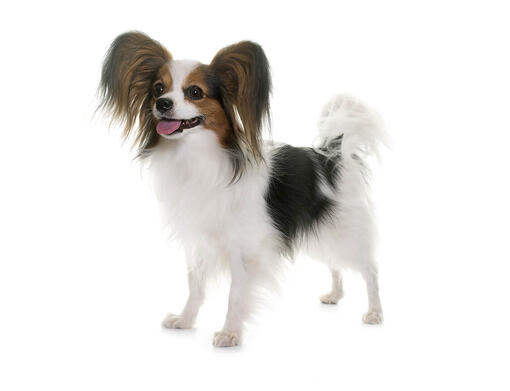
A dainty, fine-boned toy breed distinguished by his beautiful, butterfly-like ears, the Papillon was popular in France and Spain during the 16th and 17th centuries. A drop-eared type, called Phalenes, can be born in the same litter as erect-eared Papillons. Lively, friendly and alert, this elegant breed makes an excellent companion. He is happy in both city and country homes. Affectionate and playful, he does best with families who shower him with attention. The Papillon’s long, silky coat requires regular brushing.
DID YOU KNOW? Papillon means “butterfly” in French.
ALSO KNOWN AS: Continental Toy Spaniel, Phalène, Continental Toy Spaniel, Epagneul Nain Continenta
The need-to-know
- Dog suitable for non-experienced owners
- Basic training required
- Enjoys gentle walks
- Enjoys walking half an hour a day
- Small dog
- Minimum drool
- Requires grooming every other day
- Non hypoallergenic breed
- Very vocal dog
- Guard dog. Barks and alerts
- Great with other pets
- Great family dog
Personality

An alert, friendly, energetic little dog, the Papillon dog is a rewarding, loving companion that enjoys taking part in family activities, as well as spending time on laps!
History and Origins

Toy Spaniels that feature in many Renaissance paintings bear a strong similarity to the Papillon dog, and the breed is thought to have developed in France or Belgium. The Papillon dog was a favoured companion of royalty and the nobility on the Continent, and one is even said to have been carried by Marie Antoinette when she walked to the guillotine. The breed's name – which translates as 'butterfly' – comes from its large ears, which look like a butterfly with outstretched wings. If a dog has drop ears, it is called a Phalene (which translates as 'moth').
Nutrition and Feeding

Toy dogs have a fast metabolism, meaning they burn energy at a high rate, although their small stomachs mean that they must eat little and often. Small-breed foods are specifically designed with appropriate levels of key nutrients and smaller kibble sizes to suit smaller mouths. This also encourages chewing and improves digestion.
Exercise

About half an hour a day will be needed for the Papillon dog, though he is capable of more if you can offer it. For his size, he is surprisingly energetic and has competed with success in agility.
Other Information

Health and common issues
Like many small breeds, the Papillon dog can suffer from kneecaps that may temporarily slip out of place (luxating patellas). As with many breeds, hereditary eye disorders can also occur, and so eye testing is recommended.
Best family dog breeds
While many dogs are traditionally thought of as being good with children , all dogs and children need to be taught to get on with and respect each other, and be safe together. Even so, dogs and young children should never be left alone together and adults should supervise all interactions between them.